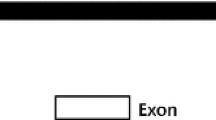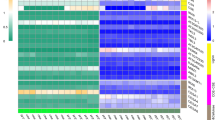Abstract
Leucaena leucocephala is a leguminous tree species accounting for one-fourth of raw material supplied to paper and pulp industry in India. Cinnamate 4-Hydroxylase (C4H, EC 1.14.13.11) is the second gene of phenylpropanoid pathway and a member of cytochrome P450 family. There is currently intense interest to alter or modify lignin content of L. leucocephala. Three highly similar C4H alleles of LlC4H1 gene were isolated and characterized. The alleles shared more than 98 % sequence identity at amino acid level to each other. Binding of partial promoter of another C4H gene LlC4H2, to varying amounts of crude nuclear proteins isolated from leaf and stem tissues of L. leucocephala formed two loose and one strong complex, respectively, suggesting that the abundance of proteins that bind with the partial C4H promoter is higher in stem tissue than in leaf tissue. Quantitative Real Time PCR study suggested that among tissues of same age, root tissues had highest level of C4H transcripts. Maximum transcript level was observed in 30 day old root tissue. Among the tissues investigated, C4H activity was highest in 60 day old root tissues. Tissue specific quantitative comparison of lignin from developing seedling stage to 1 year old tree stage indicated that Klason lignin increased in tissues with age.



Similar content being viewed by others
References
FAOSTAT (2011) Highlights on paper and paperboard: 1999–2009. In: FAO Forestry Department. http://faostat.fao.org/Portals/_Faostat/documents/pdf/Paper and paperboard.pdf. Accessed 1 Oct 2011
Shelton HM, Brewbaker JL (1994) Leucaena leucocephala—the most widely used forage tree legume. http://www.fao.org/ag/AGP/AGPC/doc/Publicat/Gutt-shel/x5556e06.htm. Accessed 1 Oct 2011
Srivastava S, Gupta RK, Arha M et al (2011) Expression analysis of cinnamoyl-CoA reductase (CCR) gene in developing seedlings of Leucaena leucocephala: a pulp yielding tree species. Plant Physiol Biochem 49:138–145. doi:10.1016/j.plaphy.2010.11.001
Dutt D, Tyagi CH, Malik RS (2007) Studies on effect of growth factor on morphological, chemical and pulp and paper making characteristics and its impact on fluff generation. Indian J Chem Technol 14:626–634
Vanholme R, Demedts B, Morreel K et al (2010) Lignin biosynthesis and structure. Plant Physiol 153:895–905. doi:10.1104/pp.110.155119
Vogt T (2010) Phenylpropanoid biosynthesis. Mol Plant 3:2–20
Boerjan W, Ralph J, Baucher M (2003) Lignin biosynthesis. Annu Rev Plant Biol 54:519–546. doi:10.1146/annurev.arplant.54.031902.134938
Hahlbrock K, Scheel D (1989) Physiology and molecular biology of phenylpropanoid metabolism. Annu Rev Plant Physiol Plant Mol Biol 40:347–369
Russell DW (1971) The metabolism of aromatic compounds in higher plants X. Properties of the cinnamic acid 4-hydroxylase of pea seedlings and some aspects of its metabolic and developmental control. J Biol Chem 246:3870–3878
Chapple C (1998) Molecular-genetic analysis of plant cytochrome P450-dependent monooxygenases. Annu Rev Plant Physiol Plant Mol Biol 49:311–343. doi:10.1146/annurev.arplant.49.1.311
Ehlting J, Hamberger B, Million-Rousseau R, Werck-Reichhart D (2006) Cytochromes P450 in phenolic metabolism. Phytochem Rev 5:239–270. doi:10.1007/s11101-006-9025-1
Sakaguchi M, Mihara K, Sato R (1987) A short amino-terminal segment of microsomal cytochrome P-450 functions both as an insertion signal and as a stop-transfer sequence. EMBO J 6(8):2425–2431
Achnine L, Blancaflor EB, Rasmussen S, Dixon RA (2004) Colocalization of l-phenylalanine ammonia-lyase and cinnamate 4-hydroxylase for metabolic channeling in phenylpropanoid biosynthesis. Plant Cell 16:3098–3109
Rasmussen S, Dixon RA (1999) Transgene-mediated and elicitor-induced perturbation of metabolic channeling at the entry point into the phenylpropanoid pathway. Plant Cell 11:1537–1551
Rastogi S, Dwivedi UN (2006) Down-regulation of lignin biosynthesis in transgenic Leucaena leucocephala harboring O-methyltransferase gene. Biotechnol Prog 22:609–616. doi:10.1021/bp050206+
Shaik NM, Arha M, Nookaraju A et al (2009) Improved method of in vitro regeneration in Leucaena leucocephala—a leguminous pulpwood tree species. Physiol Mol Biol Plants 15:311–318. doi:10.1007/s12298-009-0035-5
Chen BJ, Wang Y, Hu YL et al (2005) Cloning and characterization of a drought-inducible MYB gene from Boea crassifolia. Plant Sci 168:493–500. doi:10.1016/j.plantsci.2004.09.013
Pillai MM, Venkataraman GM, Kosak S, Torok-Storb B (2008) Integration site analysis in transgenic mice by thermal asymmetric interlaced (TAIL)-PCR: segregating multiple- integrant founder lines and determining zygosity. Transgenic Res 17:749–754. doi:10.1007/s11248-007-9161-4
Hartman TPV, Jones J, Blackhall NW, Power JB, Cocking EC, Davey MR (2000) Cytogenetics, molecular cytogenetics and genome size in Leucaena (Leguminosae, Mimosideae). In: Guttenberger H, Borzan Z, Schlarbaum SC, Hartman TPV (eds) Cytogenetic studies of forest trees and shrubs: Review, present status, and outlook of the future. Arora Publishers, Zvolen, pp 57–70
Radonic A, Thulke S, Mackay IM et al (2004) Guideline to reference gene selection for quantitative real-time PCR. Biochem Biophys Res Commun 313:856–862. doi:10.1016/j.bbrc.2003.11.177
Pfaffl MW (2001) A new mathematical model for relative quantification in real-time RT-PCR. Nucleic Acids Res 29:2002–2007
Lamb CJ, Rubery PH (1975) A spectrophotometric assay for trans-cinnamic acid 4-hydroxylase activity. Anal Biochem 68:554–561
Chen JY, Wen PF, Kong WF et al (2006) Changes and subcellular localizations of the enzymes involved in phenylpropanoid metabolism during grape berry development. J Plant Physiol 163:115–127. doi:10.1016/j.jplph.2005.07.006
Yeh T-F, Yamada T, Capanema E et al (2005) Rapid screening of wood chemical component variations using transmittance near-infrared spectroscopy. J Agric Food Chem 53:3328–3332. doi:10.1021/jf0480647
Yamazaki S, Sato K, Sakaguchi M et al (1993) Importance of the proline-rich region following signal-anchor sequence in the formation of correct conformation of microsomal cytochrome P-450 s. J Biochem 114:652–657
Durst F, Nelson DR (1995) Diversity and evolution of plant P450 and P450-reductases. Drug Metabol Drug Interact 12:189–206
Schoch GA, Attias R, Le Ret M, Werck-Reichhart D (2003) Key substrate recognition residues in the active site of a plant cytochrome P450, CYP73A1. Homology model guided site-directed mutagenesis. Eur J Biochem 270:3684–3695. doi:10.1046/j.1432-1033.2003.03739.x
Nelson DR, Koymans L, Kamataki T et al (1996) P450 superfamily: update on new sequences, gene mapping, accession numbers and nomenclature. DNA Cell Biol 6:1–51
Lu S, Zhou Y, Li L, Chiang VL (2006) Distinct roles of cinnamate 4-hydroxylase genes in Populus. Plant Cell Physiol 47:905–914. doi:10.1093/pcp/pcj063
Whitbred JM, Schuler MA (2000) Molecular characterization of CYP73A9 and CYP82A1 P450 genes involved in plant defense in pea. Plant Physiol 124:47–58
Bell-lelong DA, Cusumano JC, Meyer K, Chapple C (1997) Cinnamate-4-hydroxylase expression in Arabidopsis regulation in response to development and the environment. Plant Physiol 113:729–738
Kawai S, Mori A, Shiokawa T et al (1996) Isolation and analysis of cinnamic acid 4-hydroxylase homologous genes from a hybrid aspen, Poplus kitakamiensis. Biosci Biotechnol Biochem 60:1586–1597
Liu S, Hu Y, Wang X et al (2009) Isolation and characterization of a gene encoding cinnamate 4-hydroxylase from Parthenocissus henryana. Mol Biol Rep 36:1605–1610. doi:10.1007/s11033-008-9357-6
Mizutani M, Ohta D, Sato R (1997) Isolation of a cDNA and a genomic clone encoding cinnamate 4-hydroxylase from Arabidopsis and Its expression manner in planta. Plant Physiol 113:755–763
Pechter P (2001) Characterization of transgenic Aspen (Poplus tremuloides Michx.) harboring a homologous cinnamate 4-hydroxylase (C4H) transgene and analysis of two aspen 4-coumarate: CoA ligase (4CL) gene promoters. PhD Dissertation, Michigan Technological University
Hotze M, Schröder G, Schröder J (1995) Cinnamate 4-hydroxylase from Catharanthus roseus, and a strategy for the functional expression of plant cytochrome P450 proteins as translational fusions with P450 reductase in Escherichia coli. FEBS Lett 374:345–350
Fahrendorf T, Dixon RA (1993) Stress responses in alfalfa (Medicago sativa L.). XVIII: molecular cloning and expression of the elicitor-inducible cinnamic acid 4-hydroxylase cytochrome P450. Arch Biochem Biophys 305:509–515
Betz C, Mccollum TG, Mayer RT (2001) Differential expression of two cinnamate 4-hydroxylase genes in “Valencia” orange (Citrus sinensis Osbeck). Plant Mol Biol 46:741–748
Frank MR, Deyneka JM, Schuler MA (1996) Cloning of wound-induced cytochrome P450 monooxygenases expressed in pea. Plant Physiol 110:1035–1046
Park JH, Park NI, Xu H, Park SU (2010) Cloning and characterization of phenylalanine ammonia-lyase and cinnamate 4-hydroxylase and pyranocoumarin biosynthesis in Angelica gigas. J Nat Prod 73:1394–1397
Ro DK, Mah N, Ellis BE, Douglas CJ (2001) Functional characterization and subcellular localization of poplar (Populus trichocarpa x Populus deltoides) cinnamate 4-hydroxylase. Plant Physiol 126:317–329
Sewalt VJH, Ni W, Blount JW et al (1997) Reduced lignin content and altered lignin composition in transgenic tobacco down-regulated in expression of l-phenylalanine ammonia-lyase or cinnamate 4-hydroxylase. Plant Physiol 115:41–50
Kumar S, Omer S, Chitransh S, Khan BM (2012) Cinnamate 4-Hydroxylase downregulation in transgenic tobacco alters transcript level of other phenylpropanoid pathway genes. Int J Adv Biotechnol Res 3:545–557
Acknowledgments
The authors thank Council of Scientific and Industrial Research (CSIR, Govt. of India) for funding the project. SK and KP thankfully acknowledge CSIR; and SO thanks Department of Biotechnology (Govt. of India) for giving assistance in the form of Junior and Senior Research Fellowship. We also thank Dr. David Nelson, University of Tennessee for classifying and assigning names to LlC4H proteins.
Author information
Authors and Affiliations
Corresponding author
Additional information
Santosh Kumar and Sumita Omer contributed equally to this study.
Electronic supplementary material
Below is the link to the electronic supplementary material.
Rights and permissions
About this article
Cite this article
Kumar, S., Omer, S., Patel, K. et al. Cinnamate 4-Hydroxylase (C4H) genes from Leucaena leucocephala: a pulp yielding leguminous tree. Mol Biol Rep 40, 1265–1274 (2013). https://doi.org/10.1007/s11033-012-2169-8
Received:
Accepted:
Published:
Issue Date:
DOI: https://doi.org/10.1007/s11033-012-2169-8




